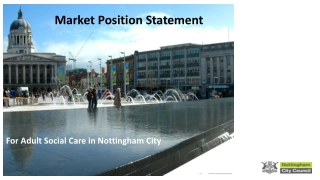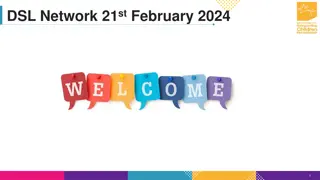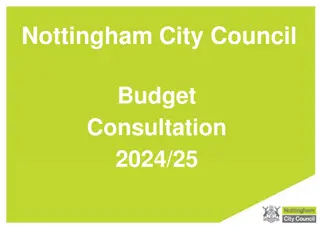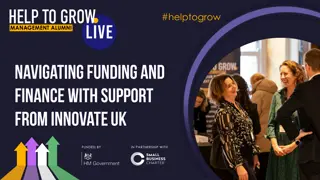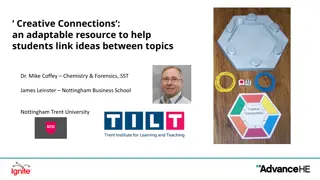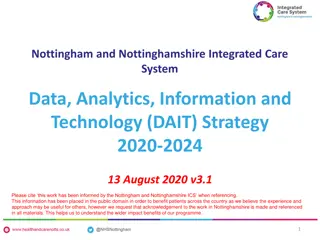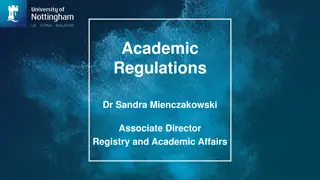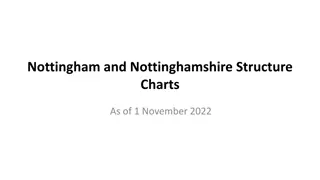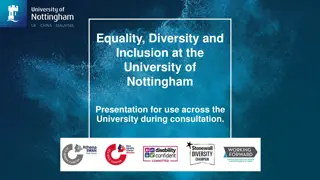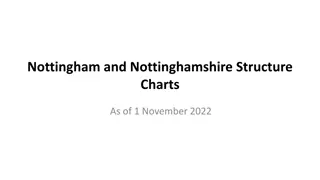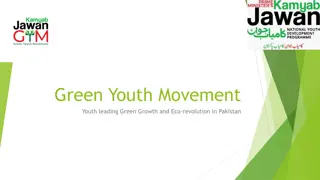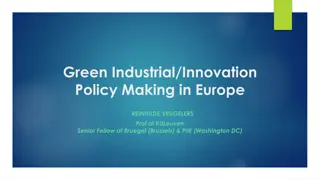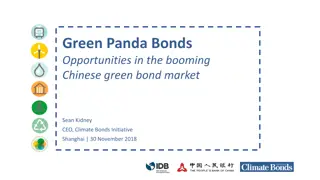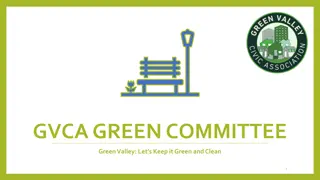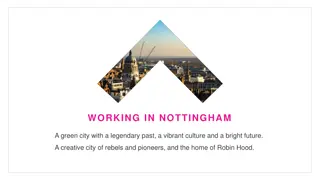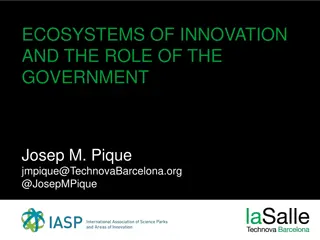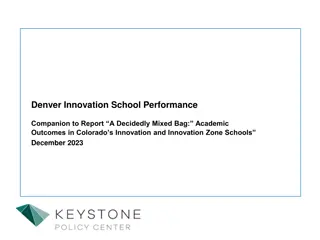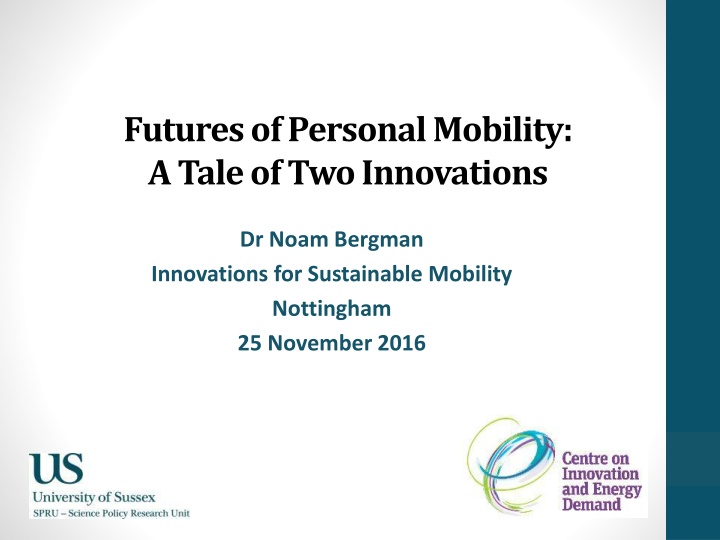
Innovative Approaches to Future Mobility Trends
Explore the future of personal mobility through two key innovations: Electric Vehicles (EVs) and Car Clubs. Understand the challenges and opportunities for sustainable transportation in the UK, focusing on reducing emissions, congestion, and changing mobility behaviors. Gain insights from expert studies projecting visions of future transport scenarios.
Download Presentation

Please find below an Image/Link to download the presentation.
The content on the website is provided AS IS for your information and personal use only. It may not be sold, licensed, or shared on other websites without obtaining consent from the author. If you encounter any issues during the download, it is possible that the publisher has removed the file from their server.
You are allowed to download the files provided on this website for personal or commercial use, subject to the condition that they are used lawfully. All files are the property of their respective owners.
The content on the website is provided AS IS for your information and personal use only. It may not be sold, licensed, or shared on other websites without obtaining consent from the author.
E N D
Presentation Transcript
Futures of Personal Mobility: A Tale of Two Innovations Dr Noam Bergman Innovations for Sustainable Mobility Nottingham 25 November 2016
Outline 1. Introduction context and project overview 2. Imagining the future people, behaviour, mobility 3. Incumbent strategies what can we deduce or infer 4. Conclusions
Future Visions of Personal Mobility A CIED project which focuses on the questions: 1. How do visions of the future portray changes in UK personal mobility? 2. What innovations are considered in these visions? 3. How are people and behaviour portrayed? Dr Tim Schwanen, Director of TSU, University of Oxford
Context: UK personal mobility, sustainability and behaviour Current car-based personal mobility is unsustainable from a climate change / emissions perspective. Other issues include congestion, air quality, accessibility. Changing the (personal) transport system is notoriously difficult: system is locked-in to automobility. infrastructure of cars, roads and fuel car owning and driving norms & practices cultural representations, institutions, expertise We focus on two relevant innovations in future visions.
1. Electric Vehicles (EVs) technical emissions reduction if electricity is low-carbon. potentially maintain other aspects of automobility. challenge the system in terms of usage (range, recharging), infrastructure, and supply chains. have grown exponentially in number in the UK in the past few years, reaching 90,000 in 2016.
2. Car Clubs (car sharing) offer systemic change; product-to-service shift with access to mobility over ownership, integrated transport. reduce total miles driven per member through slow modes, public transport and even less travel. breaking the link between car use and ownership. 220,000+ members, 80%+ in London. Growth irregular.
Visions of future transport We looked at imagined futures in documents including visions, forecasts, pathways etc. All address road transport in the UK. They come from a variety of actors/stakeholders government, industry, consultancies, lobby groups. Written 2002-2015; projections to 2020s 2050s. 20 documents chosen, focusing on: car clubs, EVs, low C cars, UK road transport, UK economy. Far more documents address EVs than car clubs, the study focused more on EVs, with car clubs as a counterpoint .
Visions as tools & strategies Visions are powerful political tools that can: create expectations that help develop technologies; generate support from a wide array of stakeholders; develop trajectories suiting authors interests; allow action in the present based on the past. Most of the vision documents we analysed represent incumbent actors; they have resources to produce broad systemic visions.
Imagining mobility Incumbents central vision : future as past, present. Most aspects of automobility remain unchanged: high demand: car travel as a right and a necessity. cars linked to technological progress, economic growth. Sustainability narrowly defined as emissions, with technological progress seen as solution: ICEVs improve, low carbon cars (probably EVs) gradually introduced. Full potential of electric mobility is hardly explored EVs must copy conventional cars to succeed. Powerful business-as-usual message.
Imagining people Strong similarities across studies in how people are imagined: independent individuals (or households) making choices. People are portrayed as consumers or users. Roughly identical, interchangeable consumers. Heterogeneity is used to segment population or highlight range of models & brands to serve needs, preferences Little consideration of public as stakeholders, partners or holders of knowledge.
Imagining behaviour People are portrayed largely as economic rational actors: consumers whose travel behaviour is a set of choices that maximise their utility. It is acknowledged that other factors affect vehicle choice - habits, brand loyalty, familiarity, image Consumers portrayed as having a passive role in any transition, their main job is buying (green) cars. Behaviour sometimes reduced to choice of car purchased. Focus is often on how to increase demand and uptake, i.e., financial incentives, awareness and overcoming barriers.
Explaining low uptake If we had perfect knowledge of each consumer, we could obtain an accurate model for each consumer s utility score for each vehicle and so be certain of their vehicle choice. EST 2007 While there is no doubt that consumers do care about fuel costs evidence suggests that consumer behaviour does not follow a rational economic model. AEA 2013 people tend to discount heavily... future cost savings from fuel economy at the time of purchasing a car, even though it would seem to be in their own interests... King, 2007 there is a list as long as your arm of reasons why people might not be rushing out to buy green. Those reasons include concerns about: price, reliability, resale value, range and practicality, desirability, fuel efficiency. Ecolane 2011
Alternative visions Car club based visions assume: society benefits from moving away from car ownership; greater behaviour change is possible (e.g., modal shift). resulting in an integrated, service-oriented system: imagining changes to norms and behaviour; access to mobility: reduced mileage, number of cars. a broader view of sustainability and possible change. Radical change Foresight visions: What if low carbon transport doesn t deliver? What if people reject intelligent infrastructure? Stronger agency for users.
Incumbent strategies in the visions Visions are used to create expectations and legitimacy for future trajectories. Incumbents use this to press for limited, gradual change that allows them to adapt and retain power. We see this in the documents in several ways: Future similar to present and past, smooth(ish) shift Significant behaviour change, i.e., reduction in demand & modal shift, are portrayed as unrealistic. Low carbon travel is portrayed as a local, complementary measure for reducing emissions (no effect on car sales). What strategies are in the visions to pursue this agenda?
Regulations Gradual tightening of emission targets allowing for improvement in conventional vehicles and increased uptake of EVs / ULEVs. This gives the industry the required long-term security for investments in low-carbon car technology and infrastructure. Regulations should capture well-to-wheel emissions this could be a delaying tactic, as EV lifecycle emissions depend the electricity grid and the wider manufacture process. strategies inferred: delay tactics; agenda setting; minimising risk
Industry and government Different views on government s roles and responsibilities. Some support involvement, with government and industry shaping the future of the automotive strategy together. Others suggest government should focus on regulation and fiscal policy, leaving markets to the industry. Strong support for government ensuring RD&D funding. Industry and government argue for technology neutrality. strategies inferred: agenda setting; minimising risk; public-private alliances
People People are seen as users and consumers, so there is a lot said about uptake and creating & sustaining demand. Financial instruments including guaranteeing long-term support to ensure certainty for the industry Raising awareness, improving image of EVs Forum of ULEV users - understanding demand side so focus is on maximising uptake. Over time we see a shift to focusing on the demand side, such as reframing limited range as range anxiety. strategies inferred: shifting responsibility; minimising risk;
Strategies roundup agenda setting shifting risk delay tactics visions shifting responsi- bility alliance building
Conclusions (1): people People portrayed as consumers, often as rational actors despite evidence this is inaccurate. This leads to dissonance regarding low EV uptake. Behaviour seen mostly as consumer choice (of vehicle) to avoid difficulty of changing car-based behaviour? or because change is undesirable? Other roles, e.g. citizen, knowledge producer, ignored not to complicate/undermine business as usual future? Imagining people as more than consumers making rational choices is not only possible, but highly desirable in a search for a future of sustainable personal transport.
Conclusions (2): the future The central vision is portrayed as the only future. Aspects which don t align with it are ignored (peak car), marginalised (car clubs) or problematised (behaviour). Imagining EVs as a simple substitute for ICEVs could perpetuate ICEVs as they are the norm against which alternative mobility forms compete. Visions suggest various incumbent strategies are at play. Alternative visions (from non-incumbents) are vital to present a range of options and highlight assumptions. Incumbent tend to focus on limited - and limiting - change.

